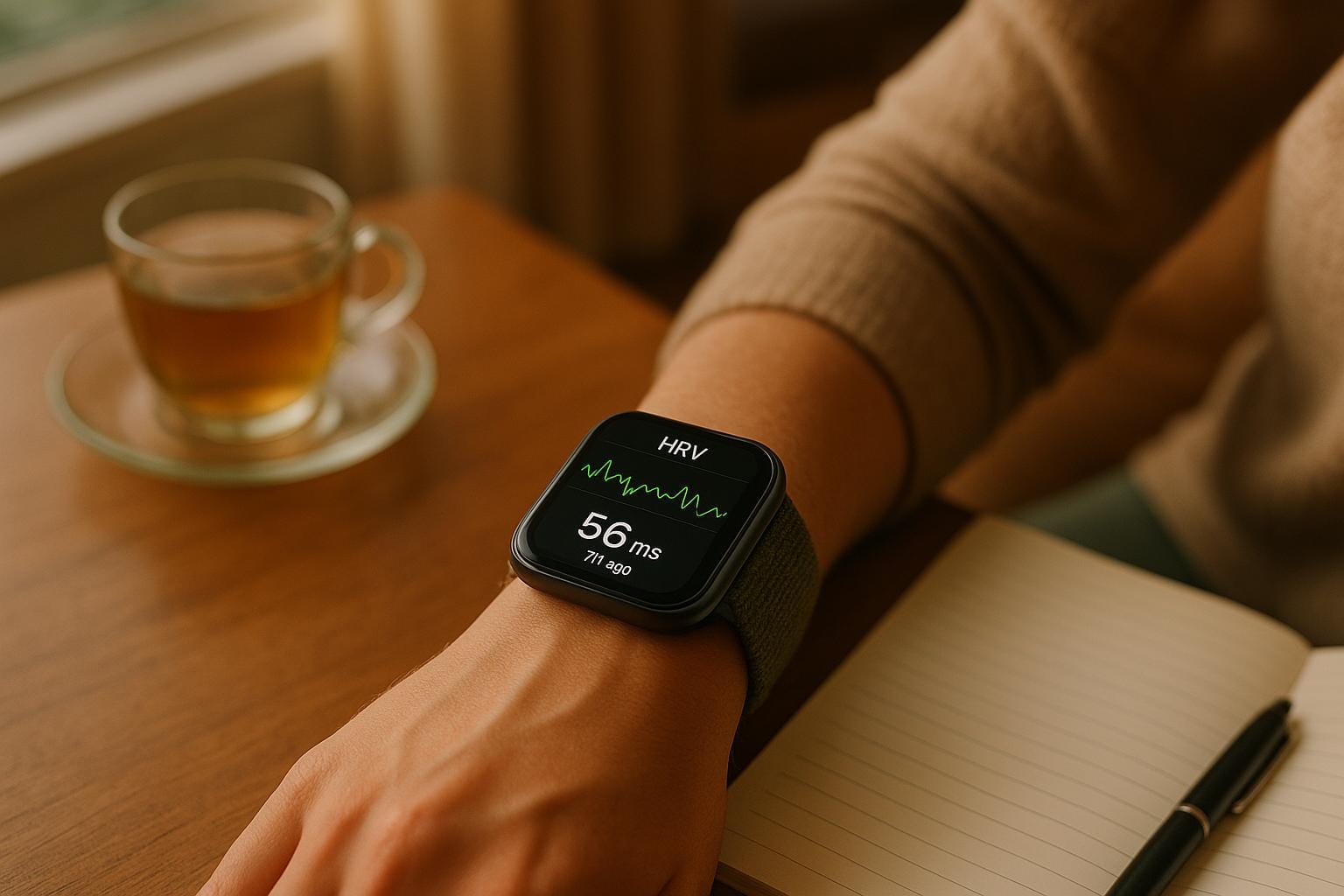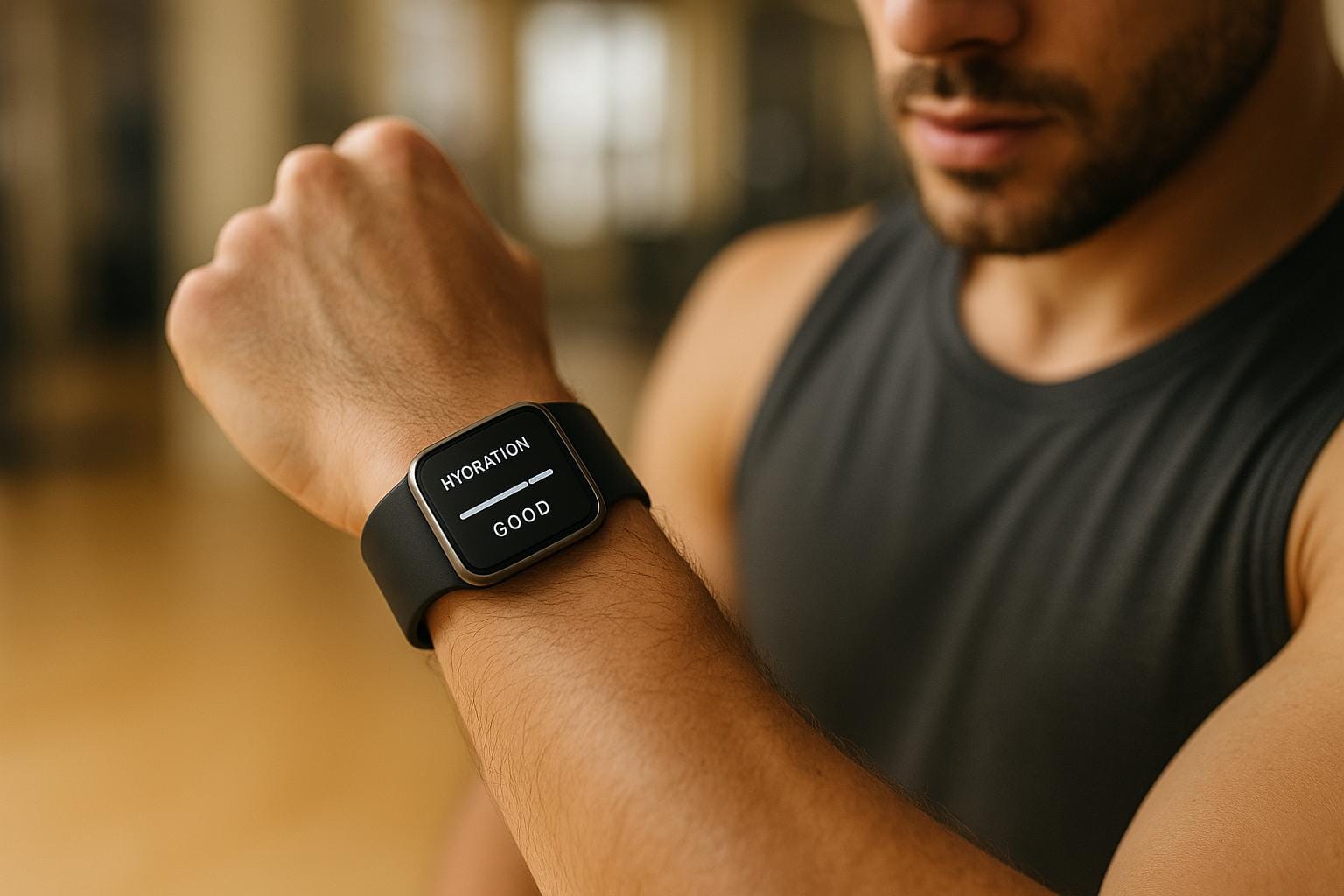Your heart rate variability (HRV) can reveal how well your body handles stress and recovers. HRV measures the tiny variations in the time between heartbeats, offering a window into your autonomic nervous system's balance. A higher HRV often signals better recovery and lower stress, while a lower HRV can indicate emotional or physical strain.
Key Takeaways:
- What HRV Measures: HRV reflects the balance between your "fight-or-flight" (sympathetic) and "rest-and-digest" (parasympathetic) systems.
- Why It Matters: High HRV means better stress resilience; low HRV may signal chronic stress, anxiety, or poor recovery.
- How to Track It: Tools like chest straps, wearables, or ECGs can measure HRV. Consistency is key - track it daily under similar conditions.
- Improving HRV: Manage stress with deep breathing, quality sleep, light exercise, and mindfulness practices.
By monitoring HRV, you can make informed lifestyle adjustments to improve your emotional and physical recovery. Read on to learn how HRV works, what affects it, and how you can use it to manage stress effectively.
305 ‒ Heart rate variability: measure, interpret, & utilize HRV for training and health optimization
How HRV Tracks Emotional Stress During Recovery
Heart rate variability (HRV) offers a fascinating window into how your body handles emotional stress and recovery. Whether you're juggling tight work deadlines or navigating personal challenges, your nervous system reacts in ways that HRV can measure.
How Emotional Stress Affects HRV Patterns
Emotional stress leaves a noticeable imprint on HRV. Acute stress, like hearing bad news or having a heated argument, causes a temporary dip in HRV that typically rebounds once the stressor passes. On the other hand, chronic stress - think ongoing relationship difficulties or relentless work pressure - can lead to a sustained reduction in your average HRV over time.
"There's a strong correlation between HRV and stress: while a lower HRV (heart rate variability) may signal stress, both mental and physical, a higher HRV can signal your body is well rested and recovered." – Victoria Peel Yates
Stressful moments often result in an elevated heart rate and a decline in HRV. Specific HRV metrics make these patterns clear. For example, stress tends to shorten the RR interval and increase the LF/HF ratio, signaling a spike in sympathetic activity. At the same time, reduced parasympathetic activity shows up as a drop in the high-frequency band alongside a rise in the low-frequency band. Mental stress can also lead to more predictable and regular RR intervals, reflecting a decrease in the heart's natural flexibility. Monitoring these changes - like shifts in the LF/HF ratio - can provide valuable feedback about stress levels and how they might be affecting recovery.
These measurable shifts in HRV pave the way for understanding the deeper neurophysiological processes at play.
The Science Behind HRV and Emotional Stress
The link between HRV and emotional stress is rooted in the brain and nervous system. Psychological stress activates the hypothalamic-pituitary-adrenal (HPA) axis and the sympathetic nervous system, which directly influence HRV.
Neuroimaging studies show that HRV is connected to brain regions like the ventromedial prefrontal cortex (vmPFC), which plays a role in regulating stress. In safe situations, the vmPFC helps suppress threat responses from the amygdala. However, chronic stress can overwhelm this system, leading to a persistent drop in HRV.
Interestingly, higher resting HRV is linked to greater activation in areas like the pre-supplementary motor area (pre-SMA) during emotional regulation tasks, suggesting a stronger ability to manage stress. Responses to stress vary widely between individuals - some may experience heightened sympathetic activity, while others show reduced vagal tone or a mix of both. This variability explains why two people exposed to similar stressors might display completely different HRV patterns.
Unlike basic heart rate measures, HRV provides a more detailed look at how your body responds to stress. It captures the timing of stress reactions and helps differentiate between physical exertion and increased sympathetic activity . When you're in a relaxed state dominated by parasympathetic activity, your HRV typically rises, signaling that your body is recovering effectively from emotional stress.
Consistently low HRV, however, can be a red flag. It's been linked to a higher risk of conditions like insomnia, chronic pain, cardiovascular issues, and anxiety disorders. By keeping track of your HRV during stressful and restful periods, you can gain valuable insights into how well your nervous system is coping with life's demands.
This article is for informational purposes only and is not intended as medical advice. Please consult a healthcare professional before starting any new fitness or wellness routine.
Key HRV Metrics for Monitoring Emotional Stress
Knowing which HRV (Heart Rate Variability) metrics to track can help you cut through the noise and focus on actionable insights. Each metric gives a glimpse into how your nervous system responds to stress, helping you make better decisions about recovery and well-being.
Primary HRV Metrics for Stress Tracking
One of the most important metrics for understanding emotional stress is RMSSD. This measure calculates the root mean square of differences between consecutive heartbeats, primarily reflecting parasympathetic nervous system activity. When you're stressed, RMSSD tends to drop as parasympathetic activity decreases. For reference, men usually average around 40 ms, while women average closer to 37 ms - useful benchmarks when determining your personal baseline.
The LF/HF ratio compares low-frequency power (0.04-0.15 Hz) to high-frequency power (0.15-0.4 Hz). This ratio typically increases under stress as sympathetic (fight-or-flight) activity rises and parasympathetic (rest-and-digest) activity declines.
High-frequency (HF) power is another key metric, specifically tied to parasympathetic activity. A decrease in HF power often signals low parasympathetic activity, while an increase in low-frequency power indicates heightened stress. When you're managing stress effectively, HF power is likely to be higher, especially during rest.
| HRV Parameter | What It Measures | Stress Response |
|---|---|---|
| RMSSD | Parasympathetic activity | Decreases during stress |
| LF/HF Ratio | Sympathetic/parasympathetic balance | Increases during stress |
| HF Power | Parasympathetic recovery ability | Decreases during stress |
| SDNN | Overall autonomic function | Varies with chronic stress |
SDNN (standard deviation of normal-to-normal intervals) offers a broader view of autonomic function, reflecting both sympathetic and parasympathetic influences. While it's not as specific for acute stress, persistently low SDNN values can point to chronic stress or reduced overall HRV.
"HRV is a valid measure of the psychological stress response. Standard stress induction and assessment protocols combined with validated HRV measures in different domains will improve the validity of findings." - Sarah Immanuel, College of Medicine and Public Health, Flinders University
Research shows that stress negatively impacts HRV in about 63% of cases, with an average drop of 4 milliseconds. These metrics provide early warnings of rising emotional stress, giving you the chance to address it before it disrupts recovery.
Choosing the Right Tools for HRV Measurement
The reliability of your HRV data depends largely on the device you use. For the most accurate readings, chest strap monitors are the go-to choice outside of medical-grade equipment.
The Polar H10 is a standout option for accuracy. In studies comparing it to medical-grade Holter monitors, the Polar H10 delivered impressive results. During high-intensity activity, it detected just 74 R-R interval errors (99.4% signal quality), while the Holter monitor recorded 1,332 errors (89.9% signal quality). Research by Gilgen-Ammann also highlighted its precision, with a mean bias of just 0.23 ± 26.8 ms and a high correlation (r = 0.997) with three-lead ECG systems.
For those who prefer wearables, the Oura Ring offers a convenient way to track stress over time. Its advanced algorithms and continuous monitoring make it a solid choice for spotting long-term patterns. However, keep in mind that wrist-worn devices are generally less accurate than chest straps.
The Whoop Strap is another popular option, providing continuous stress-tracking data. Proper fit is essential for accuracy, so ensure the strap is snug but comfortable.
If you're looking for a training-focused perspective, Garmin devices excel at linking stress data to athletic performance. As Herman Bonner from Garmin notes, "A lot of the value people get from tracking their stress comes from looking back over their days and weeks". This retrospective view can be particularly helpful in connecting emotional stress to recovery patterns.
To get the most reliable HRV data, measure during calm periods, such as first thing in the morning. Consistency is key - take readings at the same time each day under similar conditions. Using metrics like RMSSD and the LF/HF ratio can help you translate raw data into practical recovery strategies.
This article is for informational purposes only and is not intended as medical advice. Please consult a healthcare professional before starting any new fitness or wellness routine.
How to Use HRV to Manage Emotional Stress
Once you’ve got a handle on the metrics to track and the tools to measure them, the real power lies in turning that data into actionable steps. Here, we’ll dive deeper into how heart rate variability (HRV) can help you monitor and manage emotional stress effectively. The key is starting with a solid baseline and using proven recovery techniques to improve HRV when stress begins to weigh you down.
Measuring and Interpreting HRV
Start by establishing your personal HRV baseline. Track your HRV over a few weeks during calm, low-stress periods to get a reliable reference point. This baseline will help you spot significant changes that signal emotional stress.
HRV ranges vary by age. For instance, individuals in their late teens to early 20s typically see averages between 55 and 100 milliseconds, while those over 60 often range from 25 to 45 milliseconds. Because of these age-related differences, it’s more useful to compare your readings to your baseline rather than general averages.
To get consistent readings, measure your HRV first thing in the morning. This ensures you’re capturing data under similar conditions each day.
Watch for warning signs. If your HRV dips below your baseline, it’s a signal that emotional stress may be interfering with your recovery. A reading below 10 milliseconds during sleep is often a red flag for poor recovery.
Lifestyle factors like sleep, alcohol consumption, and daily stressors can influence HRV. By tracking these alongside your HRV, you can pinpoint specific triggers and work on reducing their impact.
Looking at long-term trends is just as important. Monitor your HRV over weeks or months to identify broader patterns tied to emotional stress. This approach helps you evaluate whether your stress management efforts are making a difference and if your resilience is improving over time.
Once you’ve got a clear baseline and an understanding of your patterns, it’s time to focus on recovery strategies that can help boost your HRV.
Recovery Strategies to Improve HRV
When your HRV shows signs of elevated stress, targeted recovery techniques can make a big difference. Deep breathing exercises are a great place to start. Practices like box breathing or diaphragmatic breathing can quickly engage your parasympathetic nervous system, helping to bring your HRV back up.
Another effective method is resonance breathing, which involves breathing at a steady rate of about five breaths per minute. Research shows this can increase HRV, enhance mood, and promote relaxation.
Prioritizing quality sleep is essential. Aim for 7–9 hours of restful sleep each night to support parasympathetic recovery and improve HRV. Poor sleep often correlates with lower HRV, while consistent, restorative sleep has the opposite effect.
Activities like yoga and Tai Chi combine gentle movement with mindful breathing, directly supporting parasympathetic activation and reducing stress. These practices are excellent for improving overall HRV.
Spending time outdoors can also help. Whether it’s a walk in the park or simply stepping outside for a few minutes during a busy day, being in nature can lower stress and boost HRV.
A balanced diet, such as a Mediterranean-style eating plan, along with proper hydration, supports better HRV.
Exercise balance is crucial. While regular physical activity generally improves HRV, overtraining can temporarily suppress it. Incorporate Zone 2 training and listen to your body’s recovery cues. If your HRV stays low, consider reducing the intensity of your workouts until it rebounds.
Cold exposure in small doses - like cold showers, ice baths, or brief exposure to cold air - can stimulate your vagus nerve and improve HRV. The key is to keep it short and controlled to avoid adding unnecessary stress.
Don’t underestimate the power of social connections. Positive interactions with friends, family, or loved ones can lift your mood and reduce stress, which in turn supports better HRV. Make time for meaningful relationships and social activities to build emotional resilience.
As you try these recovery strategies, monitor your HRV to see how your body responds in real time. This feedback can help you identify which methods work best for managing your stress and improving your overall recovery.
This article is for informational purposes only and is not intended as medical advice. Please consult a healthcare professional before starting any new fitness or wellness routine.
Pros and Cons of HRV for Emotional Stress Tracking
HRV tracking comes with both advantages and challenges. By understanding these, you can better incorporate HRV into your overall stress management approach.
Benefits and Limitations Comparison
One of the biggest advantages of HRV tracking is its ability to provide objective data. Unlike relying solely on how you feel, HRV measures your autonomic nervous system's response to stress in a quantifiable way. This gives you clear insights that go beyond subjective self-assessments.
Another strength lies in early detection. Regularly monitoring HRV can help you spot signs of stress before you even realize it, allowing you to address potential issues before they escalate. This proactive approach can be a game-changer for stress management.
HRV tracking can also be highly motivational. Seeing your HRV improve as a result of better sleep, regular exercise, or relaxation techniques can encourage you to stick to these healthy habits. It creates a positive feedback loop that supports long-term well-being.
However, there are some challenges to consider. Individual variability is a major factor. For instance, healthy adults typically have an HRV average of about 42 milliseconds, but this can range from 19 to 75 milliseconds. Athletes often show much higher values, around 120 milliseconds. Age also impacts HRV, with younger individuals showing higher values compared to those over 60.
External factors can also interfere with HRV readings. Things like physical fitness, lifestyle choices, environmental noise, social stress, and even your posture can affect results. This makes it harder to pinpoint emotional stress as the sole cause. Consistency in measurement conditions is crucial to get reliable data.
Another concern is device accuracy. While chest strap monitors are generally dependable, wrist-worn devices often fall short compared to medical-grade ECG equipment . Studies highlight significant differences in accuracy across consumer devices.
| Benefits | Limitations |
|---|---|
| Provides measurable, objective stress data | Individual variability complicates interpretation |
| Detects stress before you're consciously aware of it | External factors (like illness or environment) can skew results |
| Encourages healthier habits through visible progress | Consumer devices lack the precision of medical-grade tools |
| Tracks the success of stress management techniques | Requires consistent tracking and baseline establishment |
| Reflects how adaptable your nervous system is | No universal standards for interpreting HRV data |
For HRV tracking to be effective, it’s essential to balance its strengths and weaknesses. As Harvard Health Publishing explains:
"Think of HRV as another way you might tap into how your body and mind are responding to your daily experiences."
Rather than focusing solely on HRV numbers, combine them with other indicators like sleep quality, energy levels, mood, and physical symptoms. This holistic approach will give you a clearer picture of your emotional well-being and help you fine-tune your stress management strategies.
This content is for informational purposes only and is not a substitute for professional medical advice. Always consult a healthcare provider before starting any new wellness routine.
Conclusion and Key Takeaways
HRV tracking offers a clear, data-driven window into how your body responds to stress and recovers over time - going well beyond what you might feel subjectively. This deeper understanding provides a foundation for making informed decisions about managing stress and improving recovery.
Studies suggest that higher HRV reflects stronger parasympathetic activity, signaling a relaxed state and quicker recovery from both mental and physical challenges. By consistently tracking your HRV and establishing a personal baseline, you can uncover patterns in your stress responses and adjust your recovery strategies accordingly.
To get started, track your HRV daily for 2-3 weeks to establish your baseline, keeping in mind that normal ranges can vary with age. Physical therapist Vincent Luppino emphasizes the importance of focusing on your individual trends:
"It is better to follow your own individual trend of HRV over time to help you make decisions on any given day".
Your HRV data can reveal how lifestyle factors - like sleep quality, alcohol intake, hydration, and stress levels - impact your recovery.
Use your HRV as a guide. If your readings show high stress or poor recovery, consider scaling back on training intensity, prioritizing restful sleep, or practicing stress-reduction techniques like deep breathing. Combining these insights with the recovery strategies outlined earlier can help you fine-tune your approach to wellness.
Ultimately, consistency and patience are key. HRV tracking becomes most effective when it’s part of a broader strategy that also considers sleep, energy levels, and overall well-being. This holistic approach allows you to make smarter choices about when to push yourself and when to prioritize recovery, setting the stage for long-term health and effective stress management.
This article is for informational purposes only and does not replace medical advice. Always consult a healthcare professional before starting a new fitness or wellness routine.
FAQs
How can I use HRV to check if my stress management strategies are working?
You can gauge how effective your stress management methods are by keeping an eye on your heart rate variability (HRV). In simple terms, a higher HRV usually signals that your body is handling stress well and recovering effectively, while a lower HRV might indicate heightened stress or that your current strategies aren’t working as well as they could.
Practices like deep breathing exercises - such as box breathing or coherent breathing - can help boost your HRV. This improvement reflects better emotional balance and resilience. By tracking your HRV consistently, you’ll get a clearer picture of how your stress management efforts are influencing your overall well-being and recovery.
What factors can impact the accuracy of HRV measurements?
Heart rate variability (HRV) readings can be influenced by a variety of factors, including physical activity, stress, sleep quality, hydration, and even the time of day. For instance, checking your HRV immediately after exercising or during a stressful moment might not give you a clear picture of your overall recovery or health status.
For the most dependable results, it's a good idea to measure HRV under consistent conditions. A great time for this is first thing in the morning, before eating or starting any physical activity. Additionally, using a reliable, validated device specifically designed for HRV tracking can significantly improve the accuracy of your readings.
How is tracking heart rate variability (HRV) better for managing stress compared to just monitoring heart rate?
Heart rate variability (HRV) tracking gives you a more detailed insight into how your body handles stress than just monitoring your heart rate. While heart rate tells you how many times your heart beats in a minute, HRV measures the variation in time between each beat. This variation reveals how well your autonomic nervous system manages the balance between stress and relaxation.
When your HRV is higher, it’s a sign that your body is handling stress well and bouncing back effectively. On the other hand, a lower HRV might point to higher stress levels or difficulty in recovery. By focusing on HRV, you get a better understanding of your emotional health and recovery process, making it a more thorough tool for managing stress than heart rate alone.












